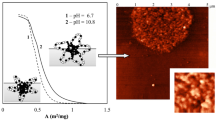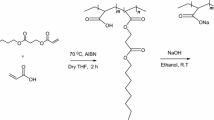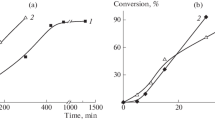Abstract
The copolymerization of 1,1,1,3,3,3-hexafluoroisopropylacrylate (HFIPA) and 2,2,3,3,4,4,5,5-octafluoropentyl acrylate (OFPA) with N-vinylpyrrolidone (NVP) in the presence of S,S’-dibenzyl trithiocarbonate (BTC) and polymeric RAFT agents based on fluoroacrylates were investigated. The copolymerization process proceeds in a control mode at any conditions investigated that was confirmed by the first order of reaction by monomer and SEC curves. Reactivity ratios of monomers were determined by the Fineman-Ross and Kelen-Tudos models. Aggregation behavior of copolymers at the air/water interface was studied by the Langmuir film balance technique. The influence of the composition and pH of the subphase on the surface properties of copolymers is considered. With the rise of subphase pH, as well as an increase in the mole fraction of NVP in the copolymer, the pressure of the plateau formation process increases. The morphology of LB films of various compositions was studied by atomic force microscopy. With the elevation in the proportion of NVP, a change in the size of micelles is traced.













Similar content being viewed by others
References
Li Z, Wang S, Yang X, Liu H, Shan Y, Xu X, Shang S, Song Z (2020) Antimicrobial and antifouling coating constructed using rosin acid-based quaternary ammonium salt and N-vinylpyrrolidone via RAFT polymerization. Appl Surf Sci 530:147193. https://doi.org/10.1016/j.apsusc.2020.147193
Mishra AK, Lim J, Lee J, Park S, Seo Y, Hwang H, Kim JK (2021) Control drug release behavior by highly stable and pH sensitive poly(N-vinylpyrrolidone)-block-poly(4-vinylpyridine) copolymer micelles. Polymer 213:123329. https://doi.org/10.1016/j.polymer.2020.123329
Zamyshlyayeva OG, Lapteva OS, Baten´kin MA, Semchikov YD, Mel´nikova NB (2014) Self-organization and aggregation of amphiphilic block copolymers of N-vinylpyrrolidone-block-2,2,3,3-tetrafluoropropylmethacrylate at interfaces. Rus Chem Bullet 63:1823–1836. https://doi.org/10.1007/s11172-014-0672-x
Zaitsev SD, Semchikov YD, Chernikova EV (2009) Controlled radical copolymerization of N-vinylpyrrolidone with 1,1,1,3,3,3-hexafluoroisopropyl-α-fluoroacrylate. Polym Sci Ser B 51:84–88. https://doi.org/10.1134/S1560090409030026
Zaitsev SD, Semchikov YD, Vasil’eva EV, Kurushina LV (2012) Controlled radical (co)polymerization of (meth)acrylic esters via the reversible addition-fragmentation chain-transfer mechanism. Polym Sci Ser B 54:205–214. https://doi.org/10.1134/S1560090412040070
Grigoreva A, Tarankova K, Zamyshlyayeva O, Zaitsev S (2021) Aggregation behaviour of poly(fluoro(meth)acrylate)-block-poly(acrylic acid) copolymers at the air/water interface. J Polym Res 28:267. https://doi.org/10.1007/s10965-021-02629-4
Grigoreva AO, Polozov EY, Zaitsev SD (2019) Effect of chain microstructure and subphase pH on the surface properties and aggregation behavior of amphiphilic copolymers based on fluoroacrylates, Key Engineering materials. Trans Tech Publications Ltd 816:312–317. https://doi.org/10.4028/www.scientific.net/KEM.816.312
Chen H, Wen G, Chrysostomou V, Pispas S, Pan W, Zuo J, Li M, Li H, Sun Z (2020) Effects of Copolymer Composition and Subphase pH/Temperature on the Interfacial Aggregation Behavior of Poly(2-(dimethylamino)ethyl methacrylate)- block-poly(lauryl methacrylate). J Phys Chem C 124:4563–4570. https://doi.org/10.1021/acs.jpcc.9b10673
You K, Wen G, Skandalis A, Pispas S, Yang S, Li H, Sun Z (2019) Effects of Subphase pH and temperature on the aggregation behavior of poly(lauryl acrylate)-block-poly(N-isopropylacrylamide) at the Air/Water interface. J Phys Chem C 123:10435–10442. https://doi.org/10.1021/acs.jpcc.9b01320
dos Santos Claro PC, Coustet ME, Diaz C, Maza E, Cortizo MS, Requejo FG, Pietrasanta LI, Ceolín M, Azzaroni O (2013) Self-assembly of PBzMA-b-PDMAEMA diblock copolymer films at the air-water interface and deposition on solid substrates via Langmuir-Blodgett transfer. Soft Matter 9:10899–10912. https://doi.org/10.1039/c3sm52336e
Chernikova EV, Terpugova PS, Garina ES, Golubev VB (2007) Controlled radical polymerization of styrene and n-butyl acrylate mediated by trithiocarbonates. Polym Sci Ser A 49:108–119. https://doi.org/10.1134/S0965545X07020022
Wang Y, Wen G, Pispas S, Yang S, You K (2018) Effects of subphase pH, temperature and ionic strength on the aggregation behavior of PnBA-b-PAA at the air/water interface. J Colloid Interface Sci 512:862–870. https://doi.org/10.1016/j.jcis.2017.11.002
Nuhn L, Overhoff I, Sperner M, Kaltenberg K, Zentel R (2014) RAFT-polymerized poly(hexafluoroisopropyl methacrylate)s as precursors for functional water-soluble polymers. Polym Chem 5:2484–2495. https://doi.org/10.1039/c3py01630g
Zhu J, Eisenberg A, Lennox RB (1992) Interfacial behavior of Block Polyelectrolytes. 5. Effect of varying Block Lengths on the Properties of Surface Micelles. Macromolecules 25:6547–6555. https://doi.org/10.1021/ma00050a025
Funding
The work was supported by the Ministry of Science and Higher Education of the Russian Federation (the basic part of the state order, project №FSWR-2023-0025).
Author information
Authors and Affiliations
Corresponding author
Ethics declarations
Conflict of interest
The authors declare that they have no competing interests.
Additional information
Publisher's Note
Springer Nature remains neutral with regard to jurisdictional claims in published maps and institutional affiliations.
Supplementary Information
Below is the link to the electronic supplementary material.
Rights and permissions
Springer Nature or its licensor (e.g. a society or other partner) holds exclusive rights to this article under a publishing agreement with the author(s) or other rightsholder(s); author self-archiving of the accepted manuscript version of this article is solely governed by the terms of such publishing agreement and applicable law.
About this article
Cite this article
Lebedev, O., Grigoreva, A., Chicharov, A. et al. pH-responsive amphiphilic copolymers based on N-vinylpyrrolidone and fluoroacrylates with different structures: synthesis via RAFT process and surface properties. J Polym Res 30, 304 (2023). https://doi.org/10.1007/s10965-023-03683-w
Received:
Accepted:
Published:
DOI: https://doi.org/10.1007/s10965-023-03683-w




